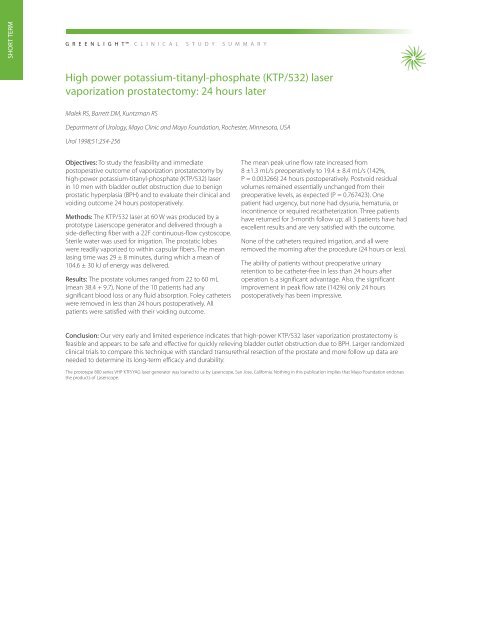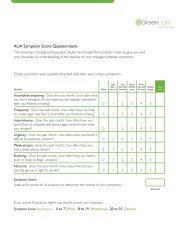C L I N I C A L S T U D Y S U M M A R Y
C L I N I C A L S T U D Y S U M M A R Y
C L I N I C A L S T U D Y S U M M A R Y
- No tags were found...
Create successful ePaper yourself
Turn your PDF publications into a flip-book with our unique Google optimized e-Paper software.
151557_GreenLightSummary_B 5/31/07 4:29 PM Page 14SHORT TERMG R E E N L I G H TC L I N I C A L S T U D Y S U M M A R YHigh power potassium-titanyl-phosphate (KTP/532) laservaporization prostatectomy: 24 hours laterMalek RS, Barrett DM, Kuntzman RSDepartment of Urology, Mayo Clinic and Mayo Foundation, Rochester, Minnesota, USAUrol 1998;51:254-256Objectives: To study the feasibility and immediatepostoperative outcome of vaporization prostatectomy byhigh-power potassium-titanyl-phosphate (KTP/532) laserin 10 men with bladder outlet obstruction due to benignprostatic hyperplasia (BPH) and to evaluate their clinical andvoiding outcome 24 hours postoperatively.Methods: The KTP/532 laser at 60 W was produced by aprototype Laserscope generator and delivered through aside-deflecting fiber with a 22F continuous-flow cystoscope.Sterile water was used for irrigation. The prostatic lobeswere readily vaporized to within capsular fibers. The meanlasing time was 29 ± 8 minutes, during which a mean of104.6 ± 30 kJ of energy was delivered.Results: The prostate volumes ranged from 22 to 60 mL(mean 38.4 + 9.7). None of the 10 patients had anysignificant blood loss or any fluid absorption. Foley catheterswere removed in less than 24 hours postoperatively. Allpatients were satisfied with their voiding outcome.The mean peak urine flow rate increased from8 ±1.3 mL/s preoperatively to 19.4 ± 8.4 mL/s (142%,P = 0.003266) 24 hours postoperatively. Postvoid residualvolumes remained essentially unchanged from theirpreoperative levels, as expected (P = 0.767423). Onepatient had urgency, but none had dysuria, hematuria, orincontinence or required recatheterization. Three patientshave returned for 3-month follow up; all 3 patients have hadexcellent results and are very satisfied with the outcome.None of the catheters required irrigation, and all wereremoved the morning after the procedure (24 hours or less).The ability of patients without preoperative urinaryretention to be catheter-free in less than 24 hours afteroperation is a significant advantage. Also, the significantimprovement in peak flow rate (142%) only 24 hourspostoperatively has been impressive.Conclusion: Our very early and limited experience indicates that high-power KTP/532 laser vaporization prostatectomy isfeasible and appears to be safe and effective for quickly relieving bladder outlet obstruction due to BPH. Larger randomizedclinical trials to compare this technique with standard transurethral resection of the prostate and more follow up data areneeded to determine its long-term efficacy and durability.The prototype 800 series VHP KTP/YAG laser generator was loaned to us by Laserscope, San Jose, California. Nothing in this publication implies that Mayo Foundation endorsesthe products of Laserscope.



